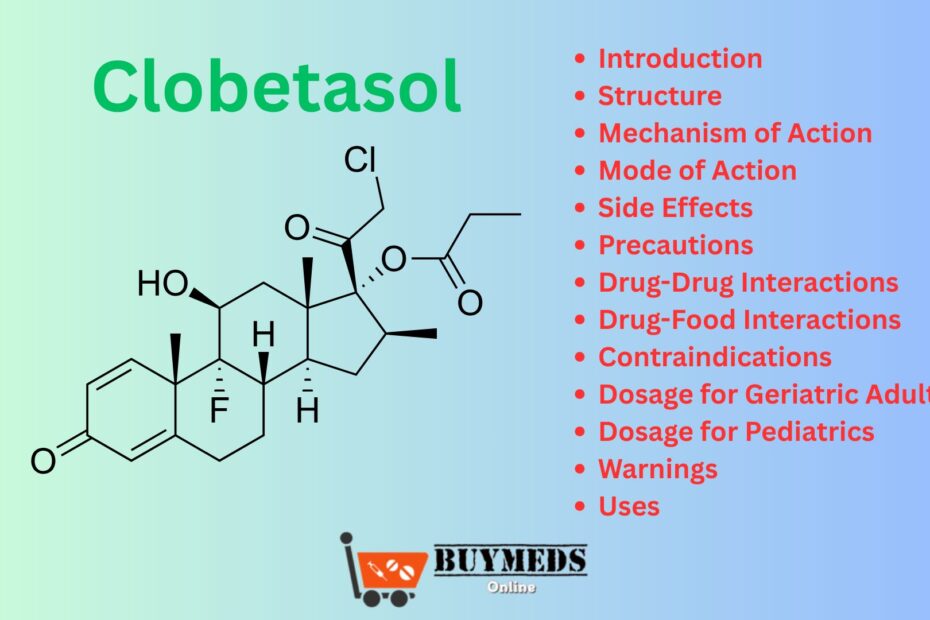Introduction
Clobetasol is a highly potent topical corticosteroid used to treat various inflammatory skin conditions. It is primarily prescribed for short-term management of diseases such as eczema, psoriasis, dermatitis, and other corticosteroid-responsive dermatoses. Due to its high potency, Clobetasol is typically recommended when less potent corticosteroids have failed to provide relief.
Structure
Clobetasol is a synthetic glucocorticoid with the chemical formula:
C₂₂H₂₈ClFO₄
IUPAC Name: (11β,16β)-21-chloro-9-fluoro-11-hydroxy-16-methylpregna-1,4-diene-3,20-dione
It is available in various formulations such as cream, ointment, gel, lotion, foam, and shampoo.
Mechanism of Action
Clobetasol binds to glucocorticoid receptors in the skin cells and alters the expression of anti-inflammatory proteins while suppressing pro-inflammatory genes. It reduces inflammation by:
-
Inhibiting phospholipase A2
-
Suppressing cytokine and prostaglandin synthesis
-
Reducing vasodilation and capillary permeability
This results in decreased redness, swelling, and itching of the skin.
Mode of Action
Once applied, Clobetasol diffuses through the skin and enters the nucleus of target cells, where it interacts with glucocorticoid response elements (GREs) on DNA. This leads to the transcription of anti-inflammatory proteins and the repression of pro-inflammatory genes. The therapeutic effect is localized due to its topical application, minimizing systemic effects if used appropriately.
Side Effects
Common side effects (especially with prolonged use or over large areas):
-
Skin thinning (atrophy)
-
Burning, stinging, or itching at the application site
-
Stretch marks (striae)
-
Acneiform eruptions
-
Perioral dermatitis
Less common but serious side effects:
-
Adrenal suppression
-
Cushing’s syndrome
-
Hyperglycemia
-
HPA axis suppression (especially with occlusive dressings)
Precautions
-
Avoid long-term use, particularly on the face, groin, or underarms
-
Do not use in broken or infected skin unless directed by a healthcare provider
-
Wash hands after application
-
Avoid eye contact
-
Do not bandage or occlude the treated area unless advised
-
Use with caution in children and elderly patients
Drug-Drug Interactions
Topical Clobetasol has minimal systemic absorption, but with extensive use or use under occlusion, systemic absorption may lead to interactions such as:
-
Enhanced hypokalemia with diuretics
-
Increased risk of hyperglycemia with antidiabetic drugs
-
Additive immunosuppression with immunosuppressants (e.g., cyclosporine)
Drug-Food Interactions
Topical Clobetasol has no significant food interactions, as it is not taken orally. However, systemic absorption from large areas can potentially influence glucose metabolism, so caution is advised in diabetic patients.
Contraindications
Clobetasol is contraindicated in:
-
Hypersensitivity to Clobetasol or any excipients
-
Viral skin infections (e.g., herpes simplex, varicella)
-
Fungal or bacterial skin infections without concurrent antimicrobial treatment
-
Rosacea
-
Perioral dermatitis
-
Acne vulgaris
-
Children under 12 years (without medical supervision)
Dosage for Geriatric and Adult Patients
Adults (including geriatrics):
-
Apply a thin layer to the affected area once or twice daily.
-
Maximum recommended duration: up to 2 consecutive weeks
-
Total weekly dosage should not exceed 50 grams
Geriatric patients may have increased risk of skin atrophy; use with caution and monitor closely.
Dosage for Pediatric Patients
-
Not generally recommended for children under 12 years unless advised by a healthcare provider
-
If prescribed, use lowest effective dose for the shortest duration
-
Monitor closely for growth retardation and adrenal suppression
Warnings
-
Prolonged use may lead to systemic absorption and adverse endocrine effects
-
Not for use on the face unless specifically advised
-
Use with caution in pregnant or breastfeeding women
-
Discontinue if irritation or sensitization occurs
-
Avoid abrupt discontinuation after prolonged use – taper gradually
Uses
Clobetasol is used in the treatment of:
-
Psoriasis (excluding widespread plaque-type)
-
Eczema
-
Lichen planus
-
Discoid lupus erythematosus
-
Seborrheic dermatitis
-
Contact dermatitis (allergic or irritant)
-
Atopic dermatitis
-
Hypertrophic lichen simplex
-
Other corticosteroid-responsive dermatoses
Expert Advice
-
Use only as prescribed, and for short durations
-
Do not use as a moisturizer or cosmetic
-
Inform your doctor if symptoms persist after 2 weeks
-
Avoid application under tight clothing that can act as an occlusive dressing
-
Monitor for skin changes or infection
-
Store in a cool, dry place, away from sunlight
FAQs
Q1: Is Clobetasol safe for long-term use?
A: No. Long-term use can lead to serious side effects, including skin thinning, adrenal suppression, and hormonal imbalances. It is meant for short-term treatment only.
Q2: Can I use Clobetasol for fungal infections?
A: No. Clobetasol can worsen fungal infections. It should not be used unless combined with an appropriate antifungal agent and prescribed by a doctor.
Q3: Is Clobetasol safe during pregnancy?
A: Use only if clearly needed and prescribed. Prolonged use or use over large areas should be avoided during pregnancy.
Q4: Can I apply Clobetasol to my face?
A: It is not recommended for use on the face due to increased risk of skin thinning and other adverse effects, unless specifically directed by a healthcare provider.
Q5: What should I do if I miss a dose?
A: Apply the missed dose as soon as you remember. If it is almost time for your next dose, skip the missed dose—do not double the dose.
Conclusion
Clobetasol is a highly effective corticosteroid for managing severe skin inflammation, but it must be used with caution. Always follow medical advice, use the lowest effective dose, and limit the duration of treatment to prevent side effects. Its potency makes it a powerful tool in dermatology when used responsibly.
Frequent Search Terms: Clobetasol, Clobetasol propionate, Clobetasol cream, Clobetasol uses, Clobetasol dosage, Clobetasol side effects, Clobetasol warnings, topical corticosteroids, Clobetasol for psoriasis, steroid cream, skin inflammation treatment.
